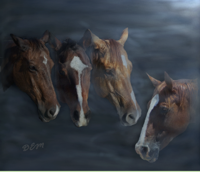
Weight Distribution
[As additional resources, links to book reviews and book purchasing information can be found beneath the quotations when this information is available.]
"My method of equitation consists in distribution of weight by the height of the neck bent at the poll and not at the withers; propulsion by means of the hocks being brought under the body; and lightness by the loosening of the lower jaw. When we know this, we know everything, and we know nothing. We know everything, because these principles are of universal application; and we know nothing, because they have to be applied practically."
James Fillis, Breaking and Riding
Buy Book
(Top)
"The further the head is away from the centre of gravity the lower it is, and the more weight is on the shoulders. The result of raising the neck, so as to bring the head near to the centre of gravity, is to more or less equalise the distribution of weight."
James Fillis, Breaking and Riding
Buy Book
(Top)
"If the fingers do not work with enough decision, the centre of gravity will be carried to the front a little too much, and the horse will be ready to go beyond the hand. If they act too strongly, too much weight will be put on the hind quarters, and the hocks will be brought too far back...We have to solve this problem at each stride, which is not identical to the preceding one or to the following one."
James Fillis, Breaking and Riding
Buy Book
(Top)
"In ordinary school equilibrium, the horse is often too much on his haunches. The great impulsion which I try to obtain always keeps my horse in horizontal equilibrium, however high the action of his fore legs may be."
James Fillis, Breaking and Riding
Buy Book
(Top)
"...the side movement of the horse naturally displaces the rider towards the side away from which the animal is going. Consequently, when the side movement is rapid, the rider can be very easily thrown off to the side away from which the movement is made. Therefore the rider ought to lean to the left, on the saddle and stirrup, during side steps from right to left."
James Fillis, Breaking and Riding
Buy Book
(Top)
"It's easy to forget that staying centered on a horse's back is real important to the horse."
Bill Dorrance and Leslie Desmond, True Horsemanship Through Feel
Read Review
Buy Book
(Top)
"You need to help the horse keep his weight rocked back while he's maneuvering the front end."
Bill Dorrance and Leslie Desmond, True Horsemanship Through Feel
Read Review
Buy Book
(Top)
"As the horse progresses through training, he becomes stronger in the rear end and can support more weight with the hind legs."
Sally Swift, Centered Riding
Read Review
Buy Book
(Top)
"At all times he [the horse] tries to come under our weight so that he can carry us more easily..."
Sylvia Loch, The Classical Rider
Read Review
Buy Book
(Top)
"As with a seesaw controlled by one person, the key is to find the centre. Only then is the rider over the source of movement and empowered to make those small changes which can affect the entire mechanism beneath them."
Sylvia Loch, The Classical Rider
Read Review
Buy Book
(Top)
"Lightness in all the disciplines comes not from less avoirdupois [a measure of weight] but from how weight is distributed."
Sylvia Loch, The Classical Rider
Read Review
Buy Book
(Top)
"Looking down when riding changes your center of gravity on the horse's back, moving it farther forward and making it that much harder for the horse to lift his front end."
Robert M. Miller, D.V.M. and Rick Lamb, The Revolution in Horsemanship
Read Review
Buy Book
(Top)
"If a rider's center of gravity is lined up with the horse's center of gravity, the rider's weight will be distributed over the horse's four feet in the same proportion as the horse's own weight is distributed over them."
Kathleen Schmitt, The Seamless Seat
Read Review
Buy Book
(Top)
(Top)